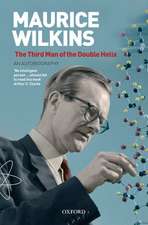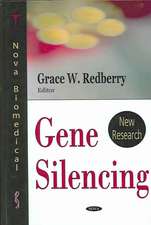The Man in the Monkeynut Coat: William Astbury and How Wool Wove a Forgotten Road to the Double-Helix
Autor Kersten T. Hallen Limba Engleză Hardback – 12 iun 2014
| Toate formatele și edițiile | Preț | Express |
|---|---|---|
| Paperback (1) | 134.56 lei 10-16 zile | +34.03 lei 7-13 zile |
| OUP OXFORD – 2 aug 2022 | 134.56 lei 10-16 zile | +34.03 lei 7-13 zile |
| Hardback (1) | 240.65 lei 31-37 zile | |
| Oxford University Press – 12 iun 2014 | 240.65 lei 31-37 zile |
Preț: 240.65 lei
Nou
Puncte Express: 361
Preț estimativ în valută:
46.05€ • 47.79$ • 38.49£
46.05€ • 47.79$ • 38.49£
Carte tipărită la comandă
Livrare economică 04-10 martie
Preluare comenzi: 021 569.72.76
Specificații
ISBN-13: 9780198704591
ISBN-10: 0198704593
Pagini: 256
Ilustrații: 24 b/w illustrations
Dimensiuni: 141 x 224 x 19 mm
Greutate: 0.46 kg
Editura: Oxford University Press
Colecția OUP Oxford
Locul publicării:Oxford, United Kingdom
ISBN-10: 0198704593
Pagini: 256
Ilustrații: 24 b/w illustrations
Dimensiuni: 141 x 224 x 19 mm
Greutate: 0.46 kg
Editura: Oxford University Press
Colecția OUP Oxford
Locul publicării:Oxford, United Kingdom
Recenzii
Hall draws on a much wider context, integrating events of broad societal interest during the time, which makes for an engaging read. ... will leave the reader richer for the experience of having read them.
Kersten Hall's delightful biography of the Leeds biophysicist William Astbury, The Man in the Monkeynut Coat, provid[es] an excellent account of the rise of x-ray crystallography and its role in revealing DNA's structure ... Hall has written a wonderful book, with a solid sense of historical context, a clear explanation of the science behind early work in biophysics, and a charming, even playful writing style that is highly readable as well as informative.
This is an excellent, stylish historical account of the early days of biophysics.
...a fine piece of historical writing rich with illuminating detail and with real excitement for the subject.
Hall's book provides a useful historical corrective to the notion that all scientists are heroes; some of them are disappointed men.
Kersten Hall has brought into the limelight a normally unsung key player in the development of modern molecular and structural biology by writing this very engaging biography of William Astbury.
Very well-written and informative
Fascinating book. I particularly enjoyed reading about Astbury's background and impressive wide-ranging activites
I have not been disappointed ... beautifully written and easy to read ... a job very well done
A very persuasive argument ... I was left in no doubt that Astbury left the scientific world a better and more interesting place
Hall tells his story with style and pace.
Construction of the Watson-Crick model of DNA in the middle of the last century was a key event in scientific history. The surrounding controversies and the larger-than-life players have been widely described but continue to fascinate. By focussing on the lesser known figure of William Astbury, a pioneer in X-ray diffraction studies of biological fibres, this readable account brings a fresh interpretation and new insight. Astbury, widely regarded as a founder of molecular biology, is also shown to have had an understanding of protein structure that was ahead of its time, an understanding that helped create new textiles and a 'monkeynut' coat.
This fascinating biography of the founder of molecular biology, the biocrystallographer William Astbury, reads like detective story. Very rich in details, it paints a vivid picture of the scientific scene round Astbury, and reveals some unknown key aspects of the quest for the structure of DNA
The storyline works very well and I was gripped from the beginning to the end of the book. The author describes numerous stories that capture the human interest aspects of doing science, with its pains and its jubilations.
In The Double Helix, James Watson wrote the Leeds scientist William Astbury out of the story of what, for many, is the greatest biological discovery of the twentieth century. With this superb book, Kersten Hall has written Astbury back in. The result is far more than the biography we have long needed of this colourful and creative pioneer of molecular biology (as Astbury was among the first to call it). In Hall's marvellously readable and deeply researched pages, the development of that science emerges as inseparable from the fortunes of the textiles industry -- and from the misfortunes of a man who, like the monkeynut coat he helped to invent, disappeared into obscurity despite huge initial promise.
William Bragg was my scientific great grandfather, so Astbury was a kind of great-uncle, although I was largely unaware of him until I started reading histories of DNA. Thus, it was a bit like reading a family history for me...I thoroughly enjoyed the book.
Kersten Hall presents an engaging and sympathetic picture of Astbury, his students and the greats in the field of x-ray crystallography ... The book is written for the general reader, so those wanting a deeper insight into the actual structural biochemistry which so absorbed Astbury ... At less than £19 for this well-produced hard-back book, I view it as good value.
This is an excellent account of molecular biology and Astbury's role in its history.
Kersten Hall's delightful biography of the Leeds biophysicist William Astbury, The Man in the Monkeynut Coat, provid[es] an excellent account of the rise of x-ray crystallography and its role in revealing DNA's structure ... Hall has written a wonderful book, with a solid sense of historical context, a clear explanation of the science behind early work in biophysics, and a charming, even playful writing style that is highly readable as well as informative.
This is an excellent, stylish historical account of the early days of biophysics.
...a fine piece of historical writing rich with illuminating detail and with real excitement for the subject.
Hall's book provides a useful historical corrective to the notion that all scientists are heroes; some of them are disappointed men.
Kersten Hall has brought into the limelight a normally unsung key player in the development of modern molecular and structural biology by writing this very engaging biography of William Astbury.
Very well-written and informative
Fascinating book. I particularly enjoyed reading about Astbury's background and impressive wide-ranging activites
I have not been disappointed ... beautifully written and easy to read ... a job very well done
A very persuasive argument ... I was left in no doubt that Astbury left the scientific world a better and more interesting place
Hall tells his story with style and pace.
Construction of the Watson-Crick model of DNA in the middle of the last century was a key event in scientific history. The surrounding controversies and the larger-than-life players have been widely described but continue to fascinate. By focussing on the lesser known figure of William Astbury, a pioneer in X-ray diffraction studies of biological fibres, this readable account brings a fresh interpretation and new insight. Astbury, widely regarded as a founder of molecular biology, is also shown to have had an understanding of protein structure that was ahead of its time, an understanding that helped create new textiles and a 'monkeynut' coat.
This fascinating biography of the founder of molecular biology, the biocrystallographer William Astbury, reads like detective story. Very rich in details, it paints a vivid picture of the scientific scene round Astbury, and reveals some unknown key aspects of the quest for the structure of DNA
The storyline works very well and I was gripped from the beginning to the end of the book. The author describes numerous stories that capture the human interest aspects of doing science, with its pains and its jubilations.
In The Double Helix, James Watson wrote the Leeds scientist William Astbury out of the story of what, for many, is the greatest biological discovery of the twentieth century. With this superb book, Kersten Hall has written Astbury back in. The result is far more than the biography we have long needed of this colourful and creative pioneer of molecular biology (as Astbury was among the first to call it). In Hall's marvellously readable and deeply researched pages, the development of that science emerges as inseparable from the fortunes of the textiles industry -- and from the misfortunes of a man who, like the monkeynut coat he helped to invent, disappeared into obscurity despite huge initial promise.
William Bragg was my scientific great grandfather, so Astbury was a kind of great-uncle, although I was largely unaware of him until I started reading histories of DNA. Thus, it was a bit like reading a family history for me...I thoroughly enjoyed the book.
Kersten Hall presents an engaging and sympathetic picture of Astbury, his students and the greats in the field of x-ray crystallography ... The book is written for the general reader, so those wanting a deeper insight into the actual structural biochemistry which so absorbed Astbury ... At less than £19 for this well-produced hard-back book, I view it as good value.
This is an excellent account of molecular biology and Astbury's role in its history.
Notă biografică
Kersten Hall graduated from St. Anne's College, Oxford, with BA Honours in Biochemistry before completing a PhD at the University of Leeds on the regulation of human genes by viruses. He then worked as a research fellow in molecular biology in the School of Medicine, University of Leeds. During this time he cultivated a growing interest in the history of science and is now a Visiting Fellow in the School of Philosophy, Religion and the History of Science at the University of Leeds where his research focuses on the history of genetics and molecular biology. He lives in Leeds with his wife and two sons.

















